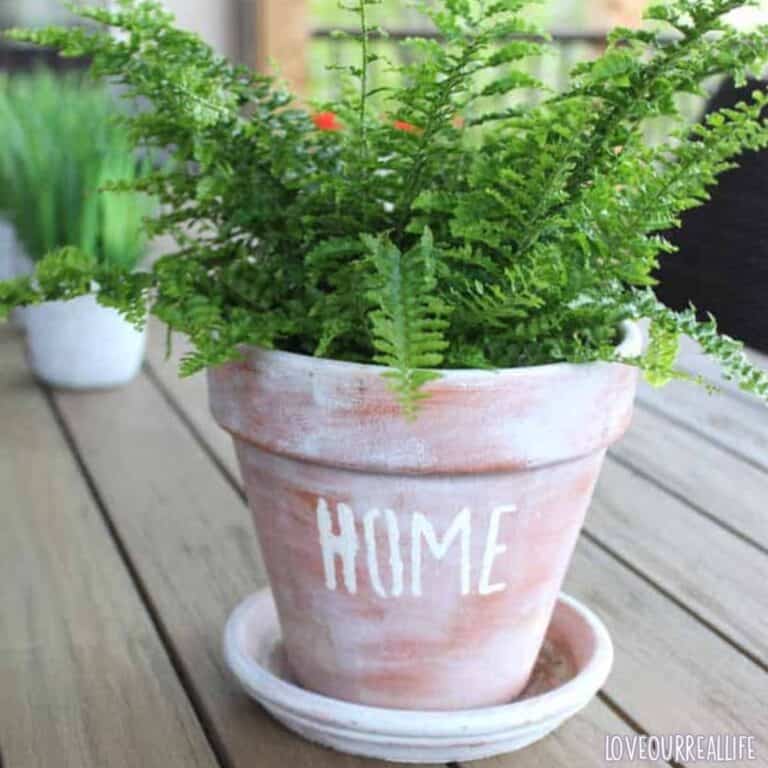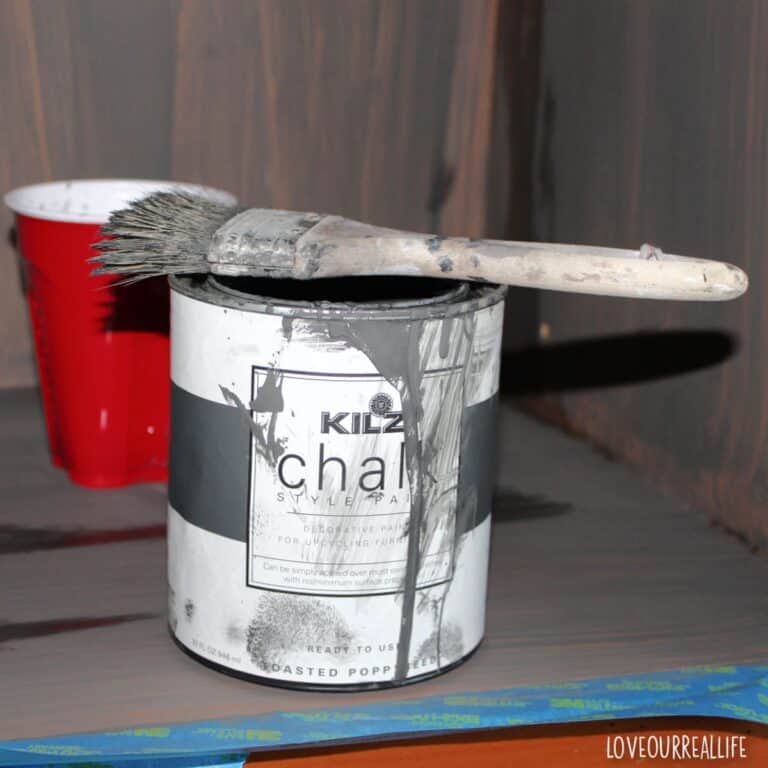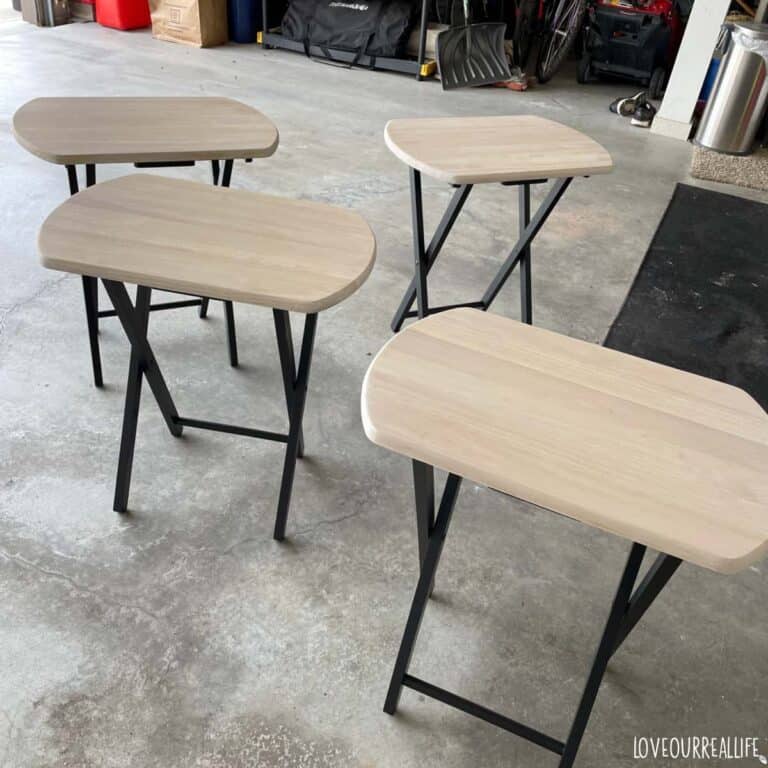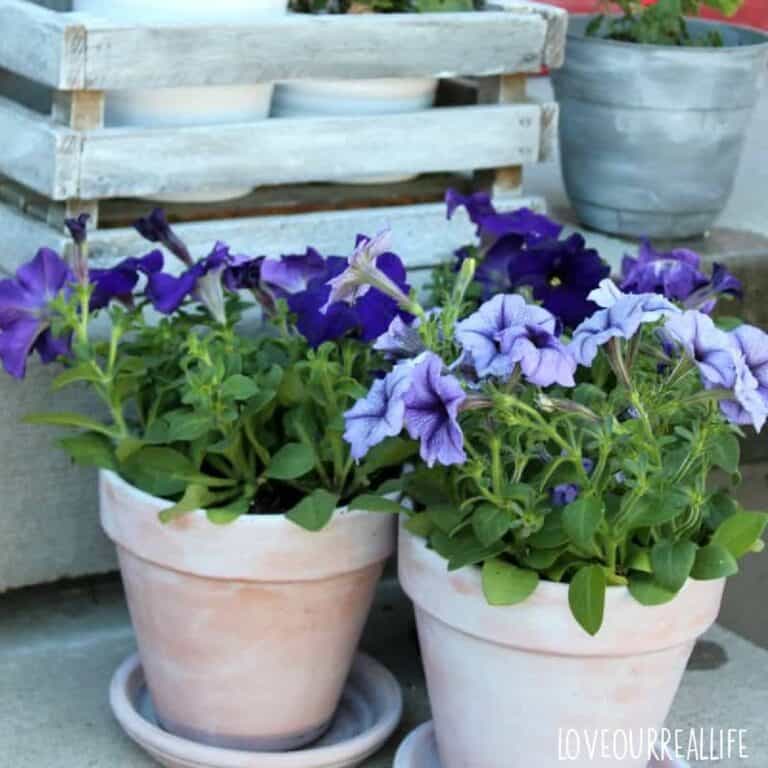Is There a Problem with Using Paint that Smells Sour?
It can be worrying to open up a can of paint and realize that it’s emitting a sour smell. Chances are that you immediately questioned whether the can of paint is still okay to use.
Whenever paint smells bad, that is a clear indication that it is time to throw it out. Canned paint should last for 2-10 years, but if it has been stored improperly or has been contaminated in some way, it’s expiration date will be much sooner than that.

Get more home painting ideas here.
Updating a room with paint (Mindful Gray is a favorite gray paint!) is an inexpensive way to quickly transform a space.
It’s best to ensure you dodge painting mistakes from the very beginning to save yourself time and money from avoidable problems.
I learned this lesson the hard way when I was indecisive about painting my front doors. If I would have taken a little more time to get it right from the beginning, I could have avoided a time consuming fix!
If you want to know more about sour-smelling paint, what makes it sour, and what to do with it, then keep on reading.
This is a problem you definitely want to take care of!
The Problem with Using Sour Paint
If your paint smells sour, that is a glaring signal that it has gone bad and needs to be thrown out immediately.
This is because whatever is making that paint smell sour is not something that you want to slather onto your walls or possessions.
Sour Paint Does Not Behave Well
If your project deadline is drawing near and you don’t have any other paint, you may be tempted to use your sour paint anyway.
This is not recommended because, once the paint has gone bad, it will not behave as fresh paint would.
Besides the smell, the following physical changes occur when paint goes bad:
- Consistency. The consistency of sour paint is not good for any project. Even if the paint adheres to the surface that you’re trying to paint, the finish will not be smooth and even. It will likely be rough and inconsistent.
- Longevity. Even if you are able to get the paint to go on smoothly, it may not last very long. Old, expired, rancid paint has the tendency to chip away prematurely.
For the previous reasons, you’re better off throwing the sour paint away and replacing it with a fresh can.
In addition to the above issues, there are some health consequences to consider with old, sour paint.
Sour Paint Can Be Dangerous
Sour paint could carry with it a few more dangers than fresh paint. The following sections will help you understand the potential dangers of sour paint.
Bacteria and Mold Make Paint Smell Sour
The smell of sour paint comes from a buildup of bacteria that has managed to grow over time.
The bacteria could have been introduced before the paint was packaged. Adding tints to paint at a hardware store is another common way that bacteria may get into the paint.
Another way that bacteria could have made it into your paint is through repeated uses of the same can of paint.
Once you open a can of paint and use it once, you introduce bacteria into the can. So, if you have used that can of paint before, this is likely how the bacteria came to be.
If mold has grown in your paint, this could add to its funk.
Though mold does not always smell bad, in some cases, it could give off a musty smell.
Why Sour Paint Can Be Dangerous
Sour paint is inherently more dangerous than fresh paint because of the bacteria and mold that could be present in the paint.
Applying this contaminated paint on your walls could lead to the following symptoms if someone inhales the fumes:
- Coughing
- Skin rash
- Irritated eyes
- Allergic reaction
The symptoms and their severity will depend on the type of mold and bacteria that are present in your stinky paint. So, if your paint is sour, it is better to throw it out than try to use it anyway.

Getting rid of Sour Paint Smell
If you’ve gone ahead and painted the room with the stinky paint, you probably regret it, as that smell can linger on the walls or whatever surface you painted.
You can try the following to get rid of the awful smell.
Wash the Painted Surface
Use a bleach mixture to wipe down the walls. If the paint was especially sour, this may need to be done multiple times to get rid of the smell.
This method may not work in all cases, and if you painted an exceedingly large area, scrubbing the whole area may be too much work.
Of course, if you are working with bleach, ensure your room is properly ventilated.
Repaint the Surface
If you have tried to wash the paint to no avail, or you would rather cover up the smell, you can try repainting the area with fresh paint.
Only do this if the current paint is completely dry. You don’t want to mix the fresh paint with the sour paint.
Make sure that you follow up the repainting session with a good primer, like INSL-X Stix. This may help to keep the smell at bay.
I used this primer when I painted my basement countertops and it is definitely a quality product.
How to Store Paint to Maximize Shelf Life
To prevent future sour paint fiascos, it is imperative to properly store your paint. This will maximize the shelf life of your paint.
Paint Gets Rancid with Age
The reason why paints have expiration dates is that paint does get old and rancid over time.
As briefly mentioned earlier, paint can last anywhere from 2-10 years before it is unfit to use. The exact amount of time that paint will list depends on the brand and type of paint.
Estimations for how long paint lasts differ based on who you ask.
According to Bob Villa, latex paints, as well as water-based acrylic paints, last up to 10 years, and that oil-based paints and alkyd paints can last up to 15 years. A very different estimate comes from a PPG paint specialist, who says that both latex and oil-based paint last only 2 years.
The best way to know how long your paint lasts is to check the container that it is in. There should be an expiration date right there on the can.
Proper Paint Storage
Whether you’re storing new paint or opened paint, it’s imperative to store it in a cool, dry place.
Ensure that no sunlight can get to your paints and that the location that you choose does not get colder than 32 degrees in the winter months.
If you have already opened a can of paint, do your best to close the can up and seal it before storing it.
The seal should be airtight. You can do this by cleaning any paint out of the inside groove along the rim of the can. If you can get this part clean, you will be able to close the can completely and ensure an airtight seal.
Note: Whenever you open a can of paint, it may be tempting to use a screwdriver, but this is not advised. Opening a can in this manner can cause the can to be warped, making it difficult to close should there be any leftover paint to store. You can use a paint can opener instead- they are cheap and can save you a huge headache.
Signs that Paint Is No Longer Good to Use
By this point in the article, you know that sour paint is a sign that paint is no longer good to use.
But there are several other signs that indicate that your paint is at the end of its life. They are outlined in the below list:
- Lumps. If you’ve ever worked with lumpy paint, you know that it’s frustrating and leads to a less than presentable paint job. If your paint is lumpy, save yourself the headache and throw it out.
- Jelly-like consistency. Paint with a jelly-like consistency is worthless, as there is no way to make it smooth. Your best bet is to throw it out and purchase a fresh can.
Final Thoughts
Now you know that it’s best not to use sour paint, you can take the appropriate steps to complete your project. We hope that this guide has been helpful to you in your painting project.





